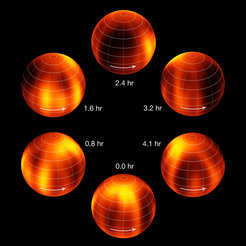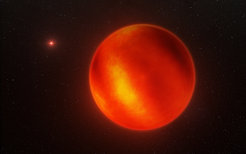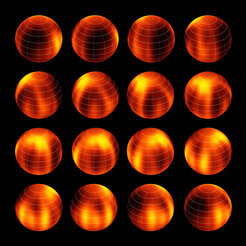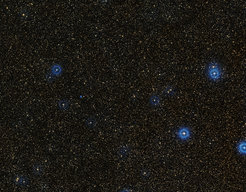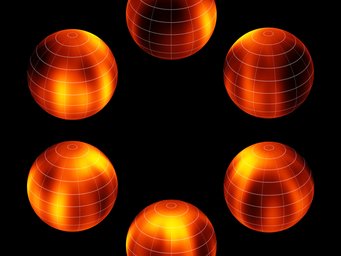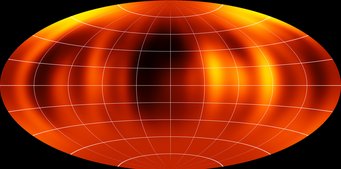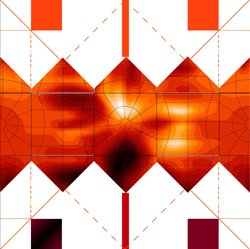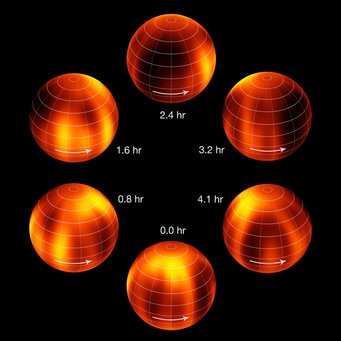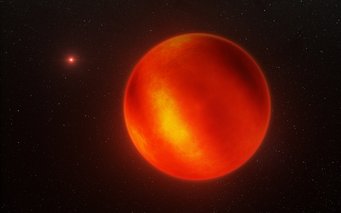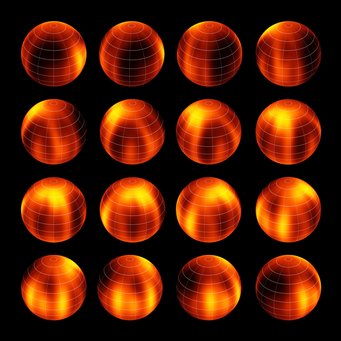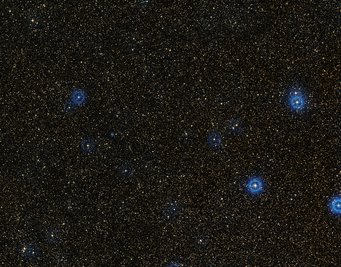First Surface map of a Brown Dwarf Shows Extraterrestrial Weather Patterns
Astronomers have presented the first detailed study of the atmospheric features – the extraterrestrial weather patterns – of a brown dwarf (an intermediate object between planets and stars). The results include the first surface map of a brown dwarf and measurements at different wavelengths probing its atmosphere at different depths. They mark the beginning of an era in which astronomers will be able to compare models for cloud formation on brown dwarfs – and, eventually, on giant gas planets in distant star systems – with observations. The results are published in the January 30, 2014 issue of the journal Nature and in Astrophysical Journal Letters.
| Templates | Questions and Answers | Images |
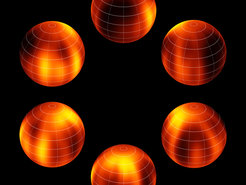
A brown dwarf is a peculiar object: more massive than a planet, but with insufficient mass for the nuclear fusion that powers stars to ignite in the object's core. The discovery of a brown dwarf system a mere 6.5 light-years away from the Sun (only two star systems are closer than that!), announced in March 2013, presented astronomers with the opportunity to study such objects in more detail than ever before.
The results of two studies of the new objects, named Luhman 16A and 16B, are in – and promise the start of a new era of research on brown dwarfs.
The first study, led by Ian Crossfield of the Max Planck Institute for Astronomy, presents nothing less than a surface map of Luhman 16B. Crossfield's team used a method known as Doppler imaging, which has never before been used with this type of objects. Crossfield explains: "Previous observations have inferred that brown dwarfs have mottled surfaces, but now we can start to directly map them. What we see is presumably patchy cloud cover, somewhat like we see on Jupiter."
The maps obtained by Crossfield and his colleagues correspond to very rough versions of satellite weather maps of our home planet. Crossfield adds: "In the future we will be able to watch cloud patterns form, evolve, and dissipate – eventually, maybe exo-meteorologists will be able to predict whether a visitor to Luhman 16B can expect clear or cloudy skies."
For humans, however, Brown Dwarf weather will always be rated as "extremely inclement". At temperatures of about 1100 C, the clouds detected by Crossfield, Biller and their colleagues are believed to be made of minute droplets of molten iron and various minerals, floating in an atmosphere that is mostly hydrogen.
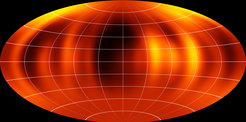
The second study, led by Beth Biller (now at the University of Edinburgh, and previously at the Max Planck Institute for Astronomy), literally goes to greater depths. As brighter and darker clouds are moved into view and removed again by a brown dwarf's rotation, its brightness will change. By simultaneously observing brightness variations at different wavelengths, Biller and her colleagues were able to reconstruct what happens in different layers of the atmosphere for both Luhman 16A and 16B.
Biller says: "We've learned that the weather pattern on these brown dwarfs are quite complex. The cloud structure of the brown dwarf varies quite strongly as a function of atmospheric depth and cannot be explained with a single layer of clouds."
The new results are the beginning of new phase of brown dwarf research in which theoreticians construct models for brown dwarf clouds, which they can then test against observations.
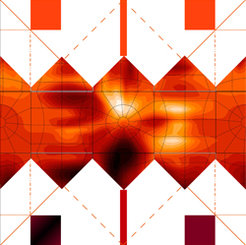
Fold your own Luhman 16B
Ian Crossfield has designed templates for a cube and an origami balloon that will give you some idea of the surface structure of Luhman 16B. Here are the PDF templates for download:
Background information
The cloud-map results described here are published as Crossfield et al., "Mapping Patchy Clouds on a Nearby Brown Dwarf" in the January 30, 2014 edition of Nature.
- Further information on Ian Crossfield's web pages
The team members are I. J. M. Crossfield (Max Planck Institute for Astronomy, Heidelberg [MPIA]), B. Biller (MPIA and Institute for Astronomy, University of Edinburgh), J. Schlieder, N. R. Deacon and M. Bonnefoy (all MPIA), D. Homeier and F. Allard (both CRAL-ENS, Lyon), E. Buenzli, Th. Henning, W. Brandner and B. Goldman (all MPIA) and T. Kopytova (MPIA and International Max-Planck Research School for Astronomy and Cosmic Physics, University of Heidelberg).
The brightness-variation results described here are published as Biller et al., "Weather on the Nearest Brown Dwarfs: Resolved Simultaneous Multi-Wavelength Variability Monitoring of WISE J104915.57-531906.1AB" in Astrophysical Journal Letters, Volume 778, Issue 1, article id. L10.
The team members are Beth A. Biller (Max Planck Institute for Astronomy, Heidelberg [MPIA] and Institute for Astronomy, University of Edinburgh), Ian J.M. Crossfield, Luigi Mancini and Simona Ciceri (all MPIA), John Southworth (Astrophysics Group, Keele University), Taisiya G. Kopytova (MPIA and International Max-Planck Research School for Astronomy and Cosmic Physics at the University of Heidelberg), Mickaël Bonnefoy, Niall R. Deacon, Joshua E. Schlieder, Esther Buenzli and Wolfgang Brandner (all MPIA), France Allard and Derek Homeier (both Centre de Recherche Astrophysique de Lyon), Bernd Freytag (Department of Physics and Astronomy, Uppsala Universitet), Coryn A.L. Bailer-Jones (MPIA), Jochen Greiner (Max-Planck Institute für extraterrestrische Physik, Garching) as well as Thomas Henning and Bertrand Goldman (both MPIA).
Questions and Answers
What's new/important about these results?
The results described here provide the first map of a brown dwarf surface, and the first monitoring of brown dwarf brightness variability in more than two wavelength ranges (filter bands) simultaneously, providing information about different atmospheric layers.
The results show distinguishable cloud features, and also that this brown dwarf must have multiple layers of patchy clouds and/or temperature variations to produce the observed variability. This is the first detection of this kind of complex, evolving weather patterns on a brown dwarf that involves a surface map, and also the first that involves monitoring at such a variety of wavelengths.
Theorists are now called upon to provide better and more detailed models for the atmospheric structure of brown dwarfs – which, in concert with new observational data similar to the one described here, should lead to a much more detailed understanding of these borderline objects.
The results are also of interest in a more general context. Theorists have already proposed various ways that weather patterns and surface features could be described on small, cool, Earthlike planets, but the observatories needed for that still lie many decades in the future. The brown dwarf map that has now been published, and the measurements by Biller et al. which provide some depth information, along with recent maps of extrasolar planets at lower resolution, represent significant progress towards the goal of understanding weather patterns in other Solar systems.
The next step is likely to involve the SPHERE instrument, an instrument scheduled to commence operations at ESO's Very Large Telescope at Paranal Observatory in early 2014. SPHERE, which was developed by a consortium headed by Jean-Luc Beuzit (PI) of the Laboratoire d'Astrophysique de l'Observatoire de Grenoble (France) and Markus Feldt (Co-PI) of the Max Planck Institute for Astronomy in Heidelberg, should be able to perform similar measurements for giant exoplanets.
Which instruments were used in this research?
The brown dwarf map was reconstructed from spectroscopic data obtained with CRIRES, a spectrograph installed on one of the 8 meter Very Large Telescopes (VLT) at ESO's Paranal observatory in Chile in May 2013.
The brightness measurements by Biller et al. used the astronomical camera GROND at the 2.2 m telescope at ESO's La Silla observatory in Chile in April 2013. GROND was built by the high-energy group of the Max Planck Institute for Extraterrestrial Physics in Garching in collaboration with the Tautenburg State Observatory and ESO, and it can take images simultaneously in seven different wavelength regions (filter bands).
The original discovery of the brown dwarf binary was made by Kevin Luhman Pennsylvania State University in mid-March 2013, using data from NASA's infrared observatory WISE. Their catalogue numbers are WISE J104915.57-531906.1 A and B, with A and B the conventional way of denoting double star (or brown dwarf) components. This is the closest star system found in nearly a century. It is only slightly more distant than the second-closest star, Barnard's star discovered in 1916. As Luhman had previously discovered 15 other binary systems, the new system has also been called Luhman 16; a convention adopted in this text.
How did the researchers manage to reconstruct a surface map, and how did they uncover the layer structure?
With current technology, it is not possible to produce surface maps of this brown dwarf (or other distant stars and brown dwarfs) in the same way that we would, say, map the cloud bands of Jupiter, namely by directly taking images that show all the details.
The indirect technique used instead is called Doppler imaging. It makes use of the fact that light from a rotating star is slightly shifted in frequency as the star rotates. From the systematic shifts, an approximate map of the stellar surface can be reconstructed.
For a rough picture of how this happens, imagine that you are hovering high above the Earth's equator, watching the globe spin beneath you. As an object sitting on the equator comes into view, it will first move toward you while crossing the horizon and coming into sight; as it passes directly beneath you, its distance from you will change very slowly, and as it passes across your horizon out of sight, it will move away from you at speed. An object placed at higher latitudes (that is, shifted towards one of the poles) will follow a similar pattern, but at overall lower speeds. An object situated at one of the poles will not move towards you or away from you at all as the Earth rotates.
Now imagine the same situation for a brown dwarf. When a bright spot rotates into sight, the way it moves directly towards or away from you will depend on latitude, while the timing of when it rotates into and out of sight defines its longitude. And while astronomers cannot follow the spot's travels directly, there's the so-called Doppler shift: Light will change its wavelength very slightly depending on whether, and how fast, the emitting object is moving towards or away from the observer. Combining the Doppler shift patterns hinting at latitude with timing carrying information about longitude, the astronomers can attempt to reconstruct the brown dwarf's surface pattern. The reconstruction involves some ambiguity and uncertainty, but the result shown here is the most probably surface structure deduced from the many Doppler measurements made by Crossfield et al.
The variability measurements by Biller et al. were made simultaneously in seven wavelength regimes (filter bands). Emission at these different wavelengths is directly correlated with the temperature of the emitting gas, and most likely the different wavelengths represent layers at different depths of the brown dwarf atmosphere. The observations thus allow the researchers to probe different depths of the atmosphere, revealing a complex pattern.
Download area

